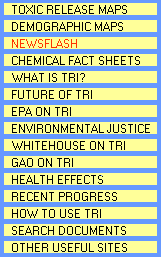
Other Potentially Toxic Facilities in Santa Cruz County
Important Books and Newsletters
TRI ACCOUNTS FOR LESS THAN ONE 1/THOUSANDTH (.1%)
OF ANNUAL U.S. PRODUCTION OF CHEMICALS
The EPA's 1997 Toxics Release Inventory (TRI) Data Release reports that nearly 6 billion (5,992,534,483) pounds of toxic chemicals were released to the environment or transfered for disposal, recycling, or burned for energy-recovery. While this is an astonishingly high figure it pales when compared to the nearly 6 Trillion (6,000,000,000,000) pounds of chemicals that are produced in the U.S. annually. This is 6 trillion pounds that each year are produced, stored, processed, transported, disposed of, combined in consumer products, or legally, illegaly, or accidentally released to the environment where, to some degree, they accumulate in our bodies and other living things in our communities.
WHY DOES TRI ONLY ACCOUNT FOR ONE 1/THOUSANDTH?
Part of the answer is that as of the 1997 reporting year TRI reporting was limited by the following:
- Only 647 chemicals of the 70,000 produced in the U.S. are on EPA's list of reportable chemicals.
- Only manufacturing facilities (sic code 20-39) must report.
- Only facilities with ten or more fulltime employees must report.
- Only facilities that manufacture or process 25,000 pounds or otherwise use 10,000 pounds of a listed chemical must report.
The other part of the answer is that TRI, as it is now formulated, has no mechanism to fully account for toxic chemical use. There are, however, efforts to make TRI more comprehensive and expand it to a full accounting of chemical use. For more information check out our Latest Right-To-Know News and Updates and check out EPA's 1997 TRI Data Release and supporting documents. Keep in mind when you read these documents, and especially reports of decreases in toxic releases and transfers, that many of these chemicals accumulate in the environment and the bodies of living things year after year. Comparing one year's releases and transfers to another does not account for this accumulation, nor does it account for the combined effects of these chemicals.
Sadly, only a handful of the approximately 70,000 chemicals produced in the U.S. have been tested for their ecological and human health effects. To read more about the dangers of these toxics, singly or in combinations please refer to the resources below:
For information on potentially toxic facilities, other than TRI, click below:
 MapCruzin.com
MapCruzin.com